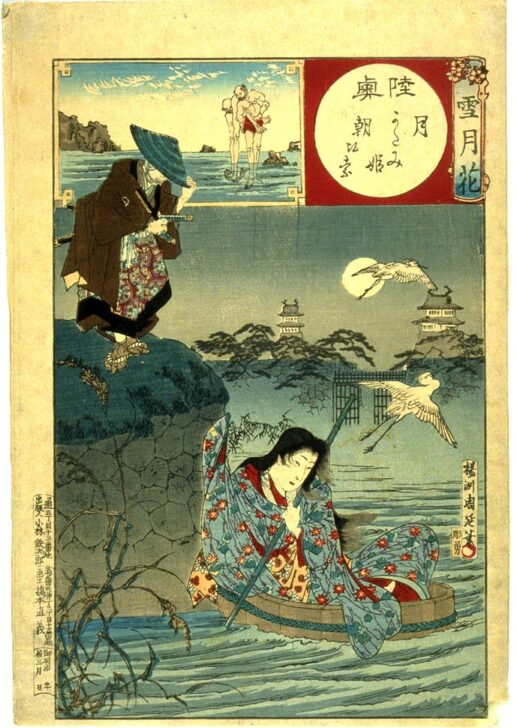Setsugekka [Snow, Moon and Flowers]: Moon over Mutsu
Toyohara Chikanobu

Description
Toyohara Chikanobu
Japan, 1838–1912
Snow, Moon, Flowers: Mutsu, Moon, Princess Katami, and
Asahina (Setsugekka: Mutsu, Tsuki, Katami-hime, Asahina)
Meiji period (1868–1912)
1885, March
Color woodblock print on paper
Gift of Pearl Sellards, 1985/1.176
This print belongs to the genre of mitate-e (meaning “see and
compare” images) prints, which contain multiple layers of
meaning for the viewer to puzzle out, both within individual
works and sometimes across a group of works. Each print in
this series is connected to a season through images of snow
(winter), the moon (autumn), or flowers (spring). This work
features two moons: the bright orb framed by two castles
in the background of the main scene and the framed circle
that echoes it above. The text inside the circle mentions the
moon, names the main characters, and describes a location
in Japan—Mutsu, which is in northern Honshu (the main
island of present-day Japan). The other prints in the series
are also linked to locations.
The print’s main subject is based on an episode from a
kabuki (Japan’s traditional theater) play. The primary scene
depicts the nighttime encounter of the thirteenth-century
warrior Wada Asahina Saburo¯ Yoshihide with Princess
Katami as she attempts to escape the castle at Hirosaki in
a wooden tub. Yoshihide was said to have met a variety of
strange people during his travels: Ashinaga (meaning "long legs") and
Tenaga (meaning "long arms"), who used their unique attributes to
fish together, are seen in the inset at the top left.
Usage Rights:
If you are interested in using an image for a publication, please visit https://umma.umich.edu/request-image/ for more information and to fill out the online Image Rights and Reproductions Request Form.